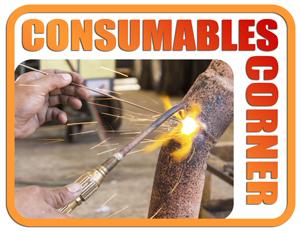Independent welding consumables professional
- FMA
- The Fabricator
- FABTECH
- Canadian Metalworking
Categories
- Additive Manufacturing
- Aluminum Welding
- Arc Welding
- Assembly and Joining
- Automation and Robotics
- Bending and Forming
- Consumables
- Cutting and Weld Prep
- Electric Vehicles
- En Español
- Finishing
- Hydroforming
- Laser Cutting
- Laser Welding
- Machining
- Manufacturing Software
- Materials Handling
- Metals/Materials
- Oxyfuel Cutting
- Plasma Cutting
- Power Tools
- Punching and Other Holemaking
- Roll Forming
- Safety
- Sawing
- Shearing
- Shop Management
- Testing and Measuring
- Tube and Pipe Fabrication
- Tube and Pipe Production
- Waterjet Cutting
Industry Directory
Webcasts
Podcasts
FAB 40
Advertise
Subscribe
Account Login
Search
Consumables Corner: Reducing weld cleanup in pulsed GMAW
- By Nino Mascalco, Rob Koltz, and Steve Sigler
- June 20, 2014
- Article
- Consumables
Q: Our company manufactures the main structures used to build fitness equipment. These structures are mild steel tubing of various shapes and sizes and in relatively thin material, typically 10 to 16 gauge. We are using 90 percent argon/10 percent CO2 shielding gas with a 0.035-in.-dia. ER70S-3 wire running in a pulse mode. Most of the welding is done in the horizontal or vertical-down position in fixtures on highly repetitive parts. Most of the welds are highly visible on the finished product, so we spend a great deal of time grinding and removing weld spatter. How can we reduce this weld cleanup time?
A: This is a common occurrence with this type of application. Typically with manual welding on repetitive parts welded in a fixture, you may at times feel the need to increase the weld parameters to meet production quotas or to simply finish the welding portion faster. However, more often than not, this actually slows throughput because of cleanup requirements. It also can reduce overall welding efficiency.
One of the main concerns with pulse welding is ensuring that the parameters are set properly for the weld joint, welding position, and desired weld profile. Additionally, it’s essential that you understand how pulse welding is designed to operate, what its intended advantages are, and how to set the parameters with proper weld puddle manipulation in mind.
Regardless of the welding position, the welding arc in pulse welding mode should make a distinct and uniform humming or buzzing sound. If you hear popping or crackling sounds, this is where a majority of the weld spatter originates. This typically means that the wire feed speed is too high for the arc length or voltage.
Another cause of weld spatter is incorrect manipulation of the puddle. For pulse welding to run optimally, you need to keep the arc out in front of the weld puddle and transition in a smooth and steady motion across the weld joint. If you are using a stepping technique, the constantly changing arc length forces the power source to try and adapt instantaneously to these variations. In many cases, this is the largest contributor to welding spatter in a pulse welding mode.
When welding in the vertical-down position, you will usually ride the arc on top of the puddle. This technique is widely accepted in short-circuit or spray-transfer mode; however, in pulse mode you will need to keep the arc in front of the puddle to minimize waste and reduce weld spatter.
If you haven't already done so, you will want to create some robust welding parameters and have them established with a welding procedure specification throughout the shop floor. Enforcing these parameters by locking out the welding machines (if the machines offer this feature) can reduce having to manage all welders on all shifts.
Another way to reduce cleanup time and waste is to consider using a different weld wire and shielding gas. The ER70S-3 wire is relatively cheap with decent weld performance. A slightly more expensive but good alternative wire is an ER70S-6. This classification of wire produces a smoother arc, a more fluid puddle, and slightly better bead profile, which can offset the additional cost if it reduces postweld cleanup.
The 90 percent argon/10 percent CO2 shielding gas is a blend that yields all-around good performance. To assist with a slightly smoother arc or less spatter, you could test a 95 percent argon/5 percent O2 to a 98 percent argon/2 percent O2 shielding gas blend. Some trimix blends add a small percentage of helium, which can improve bead appearance. However, helium is expensive, in short supply, and unnecessary for this application. Finally, make sure the shielding gas flow rate is adjusted to 30 to 40 cubic feet per hour.
About the Authors


Rob Koltz
Application Engineer
411 S. Ebenezer Rd.
Florence, 29501
636-485-2253
Steve Sigler
Application Engineer
411 S. Ebenezer Rd.
Florence, South Carolina 29501
636-485-2253
About the Publication
Related Companies
subscribe now

The Welder, formerly known as Practical Welding Today, is a showcase of the real people who make the products we use and work with every day. This magazine has served the welding community in North America well for more than 20 years.
start your free subscription- Stay connected from anywhere

Easily access valuable industry resources now with full access to the digital edition of The Fabricator.

Easily access valuable industry resources now with full access to the digital edition of The Welder.

Easily access valuable industry resources now with full access to the digital edition of The Tube and Pipe Journal.
- Podcasting
- Podcast:
- The Fabricator Podcast
- Published:
- 04/16/2024
- Running Time:
- 63:29
In this episode of The Fabricator Podcast, Caleb Chamberlain, co-founder and CEO of OSH Cut, discusses his company’s...
- Trending Articles
Sheffield Forgemasters makes global leap in welding technology

ESAB unveils Texas facility renovation

Engine-driven welding machines include integrated air compressors

The impact of sine and square waves in aluminum AC welding, Part I

How welders can stay safe during grinding

- Industry Events
16th Annual Safety Conference
- April 30 - May 1, 2024
- Elgin,
Pipe and Tube Conference
- May 21 - 22, 2024
- Omaha, NE
World-Class Roll Forming Workshop
- June 5 - 6, 2024
- Louisville, KY
Advanced Laser Application Workshop
- June 25 - 27, 2024
- Novi, MI



























